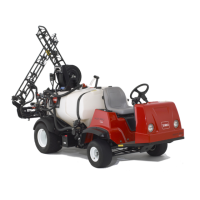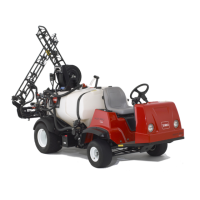Multi Pro 1750 ChassisPage 8 − 21
Bleeding Brake System
After loosening or removing any hydraulic brake compo-
nent, the brake system should be bled to insure proper
brake operation.
NOTE: A power/vacuum brake bleeding tool may pro-
vide faster and more effective brake bleeding than
manual bleeding.
1. Connect a suitable transparent hose to bleeder valve
on left rear wheel caliper and submerge other end of
hose in a clean glass container partially filled with clean
brake fluid.
2. Have a second person pump brake pedal several
times, then hold pedal down firmly.
3. With pedal firmly depressed, open bleeder valve of
left rear brake until pedal fades to floor, then close bleed-
er valve.
4. Repeat procedure until a continuous flow of brake
fluid, with no air bubbles, is released from bleeder valve.
Make sure fluid level is maintained in brake fluid res-
ervoir at all times.
5. Torque bleeder valve from 54 to 66 in−lb (6 to
7 N−m).
6. Complete steps 2 through 6 for right rear, left front
and then right front brake calipers.
7. Install hood (see Hood in this section).
CAUTION
After servicing the brakes, always check the
brakes in a wide open, level area that is free of
other persons and obstructions.
8. After bleeding of brakes is completed, test vehicle to
make sure brakes are operating correctly and brake
pedal is solid.
Bleeder valve
Figure 13
Chassis

